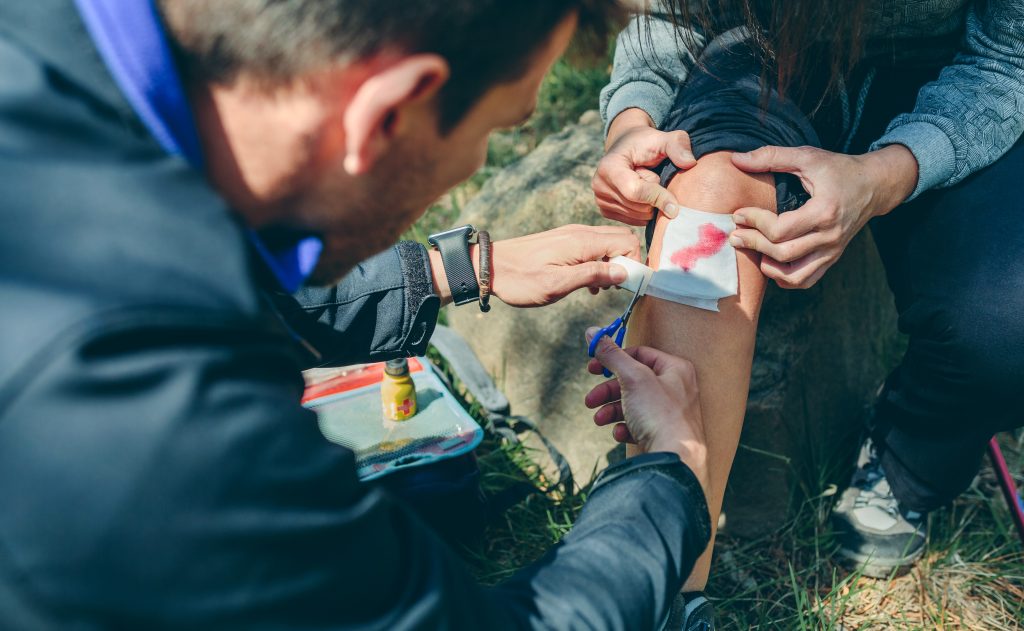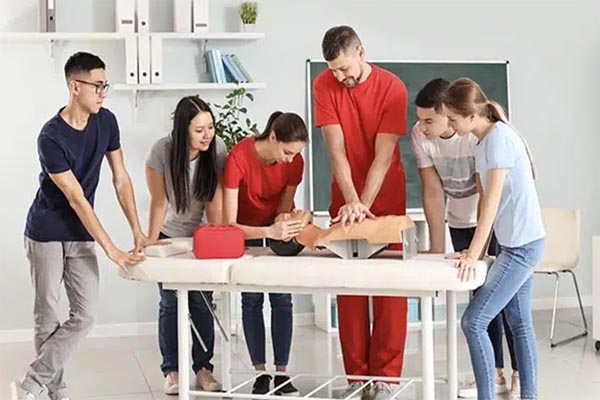
Picture this: you’re enjoying a beautiful day at the National Mall in Washington, D.C., when suddenly, someone near you collapses. Or perhaps you’re at home in Georgetown, and your child starts to choke. In these moments of panic, do you know what to do? The terms “CPR” and “First Aid” are often used interchangeably, but they are not the same. Understanding the crucial differences between them is the first step toward becoming a confident, prepared first responder. While both are essential life-saving skills, they address different types of emergencies. This guide will break down what each one entails, why you need both, and how you can get certified right here in the D.C. area.
First, let’s clarify the purpose of each. Think of First Aid as the big umbrella of emergency care. It covers a wide range of injuries and sudden illnesses, from minor scrapes to broken bones and severe bleeding. CPR, on the other hand, is a specific, specialized procedure. It is a critical skill used for one purpose: to save a person’s life when their heart has stopped beating, and they are no longer breathing. Knowing the distinction is key, as applying the wrong procedure can be ineffective or even harmful. In a city as vibrant and populated as Washington, D.C., being prepared for any emergency is not just a good idea, it’s a responsibility.
CPR: The Ultimate Life-Saving Intervention
CPR stands for Cardiopulmonary Resuscitation. It is an emergency procedure performed when someone’s heart has stopped beating. This condition, known as cardiac arrest, can happen to anyone, anywhere, and at any time. It could be a tourist suffering a heart attack near the Lincoln Memorial, or a colleague collapsing in an office building downtown. The purpose of CPR is to manually pump the blood through the body and provide oxygen to the brain and other vital organs until professional medical help arrives.
The CPR procedure involves two main components: chest compressions and rescue breaths. The chest compressions are rapid, rhythmic presses on the center of the chest. These compressions act as an external heart, forcing blood to circulate throughout the body. Rescue breaths, also known as mouth-to-mouth resuscitation, deliver oxygen to the lungs. In some cases, such as with hands-only CPR, rescue breaths are omitted, and the focus is entirely on continuous chest compressions. This is often recommended for untrained bystanders to ensure they act quickly without hesitation. The effectiveness of CPR is highly time-sensitive; for every minute that passes without CPR, the chance of survival decreases by 7 to 10 percent. This is why having trained individuals in the D.C. community is so critical.
A CPR certification course is not just about learning compressions and breaths. It also covers crucial steps like how to recognize a cardiac arrest, how to call for emergency services, and how to use an automated external defibrillator (AED). An AED is a portable electronic device that can automatically diagnose life-threatening heart rhythms and deliver an electrical shock to restore a normal rhythm. Knowing how to use an AED in conjunction with CPR dramatically increases the victim’s chances of survival. A comprehensive CPR class in Washington, D.C., will provide you with the hands-on practice and confidence needed to act decisively in a real-life emergency.

First Aid: The Foundation of Emergency Care
First Aid is the immediate care given to an injured or ill person before professional medical help arrives. Unlike CPR, which is narrowly focused on cardiac arrest, First Aid is a broad and versatile skill set. Think of it as your toolkit for a wide variety of medical emergencies. From minor injuries at the Tidal Basin to more serious incidents in the hustle and bustle of Capitol Hill, First Aid principles are applicable everywhere. The goal of First Aid is to preserve life, prevent the condition from worsening, and promote recovery.
A typical First Aid course covers an extensive range of topics. You’ll learn how to treat common injuries like cuts, scrapes, and burns. You’ll also learn to manage more serious conditions such as fractures, sprains, and dislocations. Beyond physical injuries, First Aid training prepares you to respond to medical emergencies like seizures, allergic reactions, and diabetic crises. You’ll be taught how to recognize the signs of a stroke or a heart attack—and importantly, how to take action while you wait for D.C.’s emergency medical services.
Another key component of First Aid is learning how to deal with environmental emergencies. This can include heatstroke, hypothermia, and even venomous bites. A good First Aid class also covers how to assemble and use a First Aid kit, which is an invaluable resource to have at home, in your car, or at your workplace. By learning these skills, you become a source of comfort and stability in a crisis, providing vital care that can mean the difference between a full recovery and a permanent disability.
The Synergy: CPR and First Aid Together
While CPR and First Aid are distinct, they are deeply intertwined. A complete and effective emergency response often requires both. For instance, if you encounter someone who has collapsed, your First Aid training will help you assess the scene for safety and check for responsiveness. Your CPR training will then kick in if you determine the person is in cardiac arrest. Similarly, if you’re treating a severe cut (First Aid), you must also be prepared to administer CPR if the person’s condition worsens and they lose consciousness and stop breathing.
Many certification providers, including CPR Classes Near Me, offer combined CPR and First Aid courses. This integrated training is highly recommended because it provides a comprehensive skill set for a wide range of emergencies. You learn not just the “how” but the “when” and “why” to use each technique. This holistic approach builds confidence and ensures you are ready to handle whatever life throws your way, whether you’re a parent in the suburbs of D.C., a teacher in a local school, or a professional working downtown.
Which One Do You Need?
The short answer is: you need both. While it’s possible to get certified in only one, having both certifications makes you a more capable and confident first responder.
- You need CPR Certification if: You work in a healthcare setting, are a lifeguard, or a fitness trainer. You have a family history of heart disease, or you simply want to be prepared to save a life in a sudden cardiac emergency. This skill is non-negotiable for anyone who might be in a position to encounter someone in cardiac arrest.
- You need First Aid Certification if: You are a parent, a teacher, a coach, or work with children. You are a frequent traveler or enjoy outdoor activities. You want to know how to handle everyday emergencies, from minor injuries to severe bleeding, until paramedics arrive.
- You need both if: You want to be fully prepared for any medical emergency. Having both certifications demonstrates a high level of preparedness and a commitment to the safety of those around you. It equips you with the confidence to act in a wide range of critical situations, making you an invaluable asset in your family, community, and workplace.
In a bustling city like Washington, D.C., where accidents and medical emergencies can occur at any moment, the value of having both CPR and First Aid skills cannot be overstated. You never know when you might be the first person on the scene. The seconds between the emergency and the arrival of professional help are the most critical. Your actions during that short window can determine the outcome.

Why Get Certified in Washington, D.C.?
Washington, D.C., is not just the nation’s capital; it is a community. With millions of residents, commuters, and tourists, the potential for emergencies is ever-present. From the busy streets of Penn Quarter to the quiet trails of Rock Creek Park, being a trained first responder is a valuable contribution to the safety of our city. Getting certified locally ensures the training is relevant and accessible.
Training with a reputable provider like CPR Classes Near Me guarantees you receive high-quality, hands-on instruction from certified professionals. Our courses are designed to be engaging, practical, and easy to understand. We use the latest techniques and equipment to prepare you for real-world scenarios. Our instructors are passionate about teaching these life-saving skills and empowering individuals to make a difference. We offer a variety of courses, including combined CPR/First Aid options, and we have flexible schedules to accommodate the busy lives of D.C. residents.
Conclusion
In an emergency, every second counts. Knowing the difference between CPR and First Aid is the first step toward being able to act confidently and effectively. While First Aid is the broad framework for handling a wide range of injuries and illnesses, CPR is the specialized, life-saving procedure for cardiac arrest. Both are critical skills that, when used together, can dramatically improve the outcome for a person in crisis. By getting certified in both CPR and First Aid, you become a pillar of safety for your family, friends, and community. Don’t wait for an emergency to wish you had the skills to help. Take control of your preparedness today.
Are you ready to become a certified hero? Contact CPR Classes Near Me today to learn more about our comprehensive CPR and First Aid courses available in Washington, D.C. Empower yourself with the knowledge and confidence to save a life.
FAQs about CPR Versus First Aid in Washington D.C.
Q1: How long does a CPR certification last?
A1: Most CPR certifications are valid for two years. After this period, you will need to take a recertification course to refresh your skills and stay up-to-date with the latest guidelines.
Q2: Do I need to be a medical professional to learn CPR or First Aid?
A2: No, not at all. Our courses are specifically designed for laypeople, meaning anyone can learn and become certified. The goal is to empower ordinary people to become effective first responders. No prior medical knowledge is required.
Q3: What’s the difference between Adult, Child, and Infant CPR?
A3: While the basic principles are the same, there are key differences in the techniques used for each age group, including the depth of chest compressions and the amount of air used for rescue breaths. A comprehensive course will cover all three age groups to ensure you are prepared for any situation.
Q4: Can I learn CPR or First Aid online?
A4: While some online courses offer the theoretical knowledge, the hands-on practice is crucial for developing the skills and confidence to perform CPR and First Aid correctly. Our courses often combine online components with in-person, hands-on practice sessions to ensure you are fully prepared. This blended learning approach is highly effective.
Q5: Is an AED included in CPR training?
A5: Yes, a good CPR course will always include training on how to properly use an Automated External Defibrillator (AED). AEDs are a critical component of the chain of survival for a person in cardiac arrest, and knowing how to use one is just as important as knowing how to perform chest compressions.

Leave a Reply